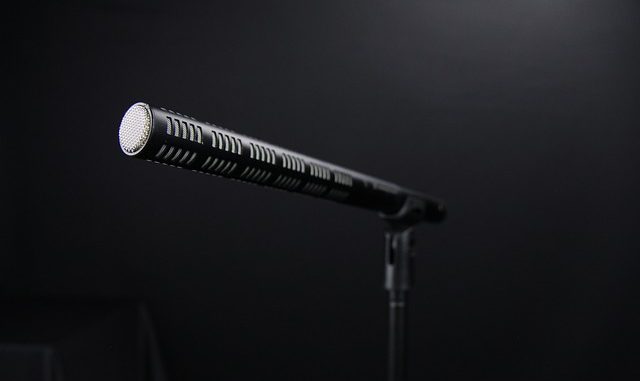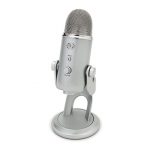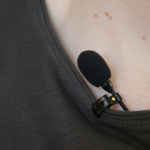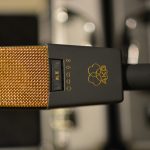
More people are making videos than ever before. In an age of YouTube and affordable electronic equipment, many of us have access to DSLR cameras and camcorders which are better than the cameras which were shooting Hollywood films not so long ago. Even our iPhones and tablets can shoot HD video, but the audio needs to be up to scratch too. Many people find themselves looking for the best on-camera microphone for DSLR or other types of camera. They usually come in the form of shotgun microphones. This allows people to record the audio for whatever their video project is, whether it is the dialog for a film, a podcast or vlogging.
Detailed Reviews of a variety of mics can be found below. To jump straight to our recommended product for pro video sound, check out the Rode VideoMic Pro
Types of On-Camera Mic
Shotgun Mics for DSLR
Shotguns are probably the most common microphones for DSLR. These will normally attach to the top of the microphone and point towards the audio target (hence the name shotgun). These types of mics are popular for picking up the whole of the action. Whether it is a group conversation or the ambient noise in a recording, shotgun microphones can get a well-rounded sound.
Lapel and Lavalier Microphones For DSLR
These are the clip-on microphones you often see on someone’s clothing (hence the name Lapel mic). They are a brilliant choice for certain specific uses such as recording someone’s voice while they speak directly to the camera. They’re also great for interviews, and even if you only have one microphone input on your camera, there are even lapel microphones with a dual mic head, so you can record from two sources into the same input.
Some people do go for handheld microphones or even headset style mics for their videos, but these are far less common and less convenient for most filming processes.
Best On-Camera Microphones Reviewed
On to our reviews. We’ve picked out multiple models of DSLR microphone to suit different budgets and requirements. There is something to suit everyone whatever you are looking for.
Rode Video Mic GO (VMGO)
The Video Mic Go has a huge amount of features and functionality that will suit most peoples’ needs when shooting video on a camcorder or DSLR. It isn’t the cheapest product, so the question wil probably be whether this fits your budget.
The Video Mic is designed to be lightweight and compact and will clip right on to the top of a standard DSLR camera. The pickup area is designed to focus in on the subject and pick up whatever is being recorded whilst also reducing ambient noise and unwanted sounds from creeping in. This is also helped by the shock mount which is built into the microphone and will avoid noises from bumps and scrapes that can occur during filming.
A windshield is included, and the mic can be used with or without it. If you are filming outside this is normally recommended, and does a great job of keeping wind noise to a minimum.
The microphone is just 73g, an incredibly lightweight product which doesn’t add to the load of the gear you’re carrying too much. It is hard to argue with the features and ease-of-use. This microphone doesn’t even require batteries and will work from the input of your camera (a minijack or 3.5mm connector).
Most of the Rode Videomic Go reviews have been exceptionally positive. There are other products available in the range including the smaller Video Mic ME, and as we will now review…
Rode VMPR VideoMic Pro
The VideoMic Pro is the elite product on the market. It is far more expensive than the rest of the Rode video microphone range. It does such an incredible job for DSLRs and camcorders, or even for iPhones or smart devices, and justifies the price tag.
The main difference in audio quality comes from this mic having a 1/2-inch condenser microphone capsule, providing more detail than its competitors and incredible clarity. Just like the Video Mic Go, it has a shock mount and windshield.
The professional, broadcast quality makes this the elite product on the market for use with SLR cameras. There are no real downsides other than the fact that it isn’t the cheapest mic you’ll find. It is more designed for professional applications, hence the price tag.
Because this is a condenser microphone it needs power, so does require a battery, fortunately, one battery can last over 70 hours.
A microphone which it is hard to find fault with, so if you are looking for crisp, clear and pro audio then look no further. For an in-depth review and audio examples, check out the video below.
Shure VP83 LensHopper Camera-Mounted Condenser Microphone
If there is a type of microphone on the market, you can almost guarantee that Shure have a product to fit the bill. This is no different for Camera microphones, and their VP83 “LensHopper” model is a good competitor for the VM Pro.
This is a condenser microphone and therefore needs power, which is simply provided via an AA battery which can give up to 125 hours of battery life. Being a directional mic, it does a good job of picking up the sounds it is pointed at (what is on camera) while rejecting other noise and unwanted audio off-camera.
This cleverly has inbuilt RF immunity, which is designed to be immune to the sounds mics can create when cellular devices such as phones and tablets nearby.
This microphone is also available with an inbuilt flash. As it will attach to the area of the camera where a flash would normally be, this can be extremely useful, and ensure you don’t lose the benefit of on-camera lighting so that you can have a mic.
The clarity of this microphone and the functionality, as well as the ease-of-use, are something we have grown to expect from Shure. The brand has a rich history of creating some of the best microphones in the whole industry, and though they perhaps aren’t the most popular or best-selling mics for DSLRs, the quality of the VP83 is undeniable. Once again, this mic has a reasonably high price tag, so is best for pro use.
Budget DSLR Mic – Neewer Uni-Directional Camera Mic
Not everyone is looking to spend hundreds of dollars to get a camera mic, and some are looking for something under $100 or even under $50, and the Neewer can be the one for you. It is available at an impressive price and even has all of the accessories you are likely to need included.
The price range makes this a popular choice for hobbyists and those starting to make videos. The audio is mono, and doesn’t have quite as good clarity as the Shure and VideoMic Pro models we have mentioned already. For a lot of home video uses, for reference audio and other amateur or hobby uses.
The microphone ships with the following:
- A wind resistant foam cap
- 2 stands
- The shotgun mic itself – 36cm long
- 1/4 inch (6.35mm) jack adaptor
- 1/8 inch (3.5mm) jack adaptor
- Jack to XLR cable (the mic itself has an XLR connection, but the jack connection the other end should plug straight into most camcorders and DSLRs)
The price and the fact that all of these accessories are included means a crazy amount of value for money. This is possibly the best ‘cheap’ shotgun style mic for use in video making we’ve come across. There are a lot of brands out there making substandard microphones and it is important to make sure you get something trusted.
The reviews of the Neewer mic are generally very good. The audio may not be likely to be used in a Hollywood film any time soon, but for a first step, this affordable microphone can make a big improvement on the audio from the built-in microphone.
Wireless DSLR Mic – Rode RodeLink Film Maker Kit
We wanted to include a wireless microphone on our list too. This is a lavalier mic, so is great for picking up a single voice, making it a good choice for podcasts, vlogging, monologues and certain Youtube videos. You can buy wireless audio systems with two microphones too.
This is surprisingly simple to use, with the main body of the kit plugging into the top of your camera, while the lavalier microphone can be clipped onto your subject. The two pair with ease and provide a reliable audio setting over distances up to 100 meters. These microphones are great if you don’t want to have wires trailing around the place. The OLED display makes it really easy to see when the mic is paired and picking up audio.
The RodeLink is a very impressive wireless system, and another product from Rode who are really leading the way in camcorder mics and slr microphone systems.
Video Microphone Accessories
Recording audio to go along with video is very different to other audio recordings, and therefore the products that go along with the process are also different. Some things we wouldn’t need for a mic for recording vocals are essential for video mics. This is especially true if you are recording on location.
Many accessories include adaptors and cables, the specific items you need to make the mic work and pick up audio. Some even have battery chargers to keep the condenser capsule working.
Wind Shields are the most common accessory. They are really important if you are recording outdoors. You don’t have to be in a particularly windy spot for a gust to come along and ruin your best take. A lot of these products are out there and aren’t expensive, so it is worth having one in your camera bag. These are often made of foam but there are better quality shields made out of fur.
Do I Need an External Microphone for my Video Camera?
This is a question a lot of people ask, especially if you are trying to make a video on a budget. Video technology has come a long way, and what is available to the average consumer is crazy now, but let’s be clear that their visuals are far superior to the audio. An external microphone is vital for getting the best quality.
The inbuilt microphone on your DSLR or video camera might be decent. For home video, or even for some YouTube videos it may be sufficient, but it won’t be clean cut and may sound unprofessional. This is especially true if you are making videos commercially or are trying to get to a professional level. Plus, there are some great budget microphones for DSLR which means that you don’t have to spend a fortune to sound far more pro.
Can I Use Different Microphones?
An On-Camera microphone is designed to plug straight into your camera and make life easier. The fact that you will have your audio not only synchronized but saved within the same file will make your life easier. This is especially true when it comes to editing, especially if you want to make complex edits.
If the camera is far away from the subject, you may also want to pick up the sound on a different device such as a portable audio recorder, so that the audio signal is as clear as possible.
Of course, if you already have a microphone such as a USB microphone, or one that plugs into a dictaphone, portable recorder or even an XLR mic, you may want to use this. To do so, the important thing is to make sure your audio is easy to synchronize. Always use a clap or snap sound to do so. More tips on syncing audio with video can be found here.
Conclusion
Of course, the product you need depends on the audio clarity you require, your budget and the specific uses, but the above list has included a wide range of products to suit pretty much every need. Whether you use Canon, Nikon or another DSLR brand doesn’t matter, all of the products will work with each camera brand and normally just require a mini jack connection.
If you have any experiences with other microphones, or the DSLR mics mentioned above, feel free to leave a comment below sharing your own thoughts.






